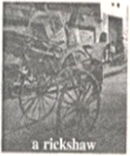
When I crossed a small road on my first day in Kolkata, I was surprised because I heard a bell-not a horn (喇叭), It was a tiny man pulling a rickshaw, He stopped and picked up two children from the front door of their house and pulled them to school. For many people, the rickshaw in Kolkata has many advantages. When the traffic is bad, rickshaws find a way through the traffic. If your miss your bus and there aren't any taxis, you can always find a rickshaw in Kolkata. Rickshaws are from your house to the market and waits for you. Then he loads (装载)all your things, drops you off outside your home and helps you unload, No other type of public transport offers this kind of service.
From June to September, Kolkata gets heavy rain. Sometimes it rains for 48 hours without a break. In some parts of the city, the roads flood (水淹), and anything with an engine(发动机) is useless, But the rickshaw drivers never stop working, even with water all around them.
But not everyone thinks rickshaws are a good thing. The local government want to ban rickshaws. They believe it is wrong for one man to pull another person when there is modern transport in the city. However, there is a problem with this plan. Many of the rickshaw drivers come from the countryside. The only job they can find in Kolkata is pulling a rickshaw, If the city bans rickshaws, these men won't have a job. So for the moment, the people of Kolkata still go by rickshaw.
小题1:What is the main idea of Paragraph 1?
A.The rickshaw drivers carry things for local people in Kolkata.
B.Parents need rickshaws for taking children to school in Kolkata.
C.Rickshaws can find a way through the bad traffic in Kolkata.
D.Rickshaws are very useful for the people's daily life in Kolkata.小题2:Which type of transport may you take when the roads flood in Kolkata?
A.A bus.
B.A taxi.
C.A car.
D.A rickshaw.小题3:What does the underlined word "ban" mean?
A.make
B.increase
C.forbid
D.collect小题4:What can we learn from the passage?
A.The rickshaws in Kolkata have loud horns.
B.The rickshaw is still a part of public transport in Kolkata.
C.The local government offer many other jobs to the rickshaw driven.
D.The people in Kolkata are supposed to take rickshaws instead of cars.
小题1:A
小题2:D
小题3:C
小题4:B
短文大意:这篇短文主要介绍了在印度城市加尔各答流行的一种运输方式,黄包车.短文详细的描述了这种运输的方式的好处以及它的社会影响.
小题1:短文第一段主要介绍了在加尔各答乘坐黄包车的一些好处.故选A,黄包车夫帮助当地人运送东西.
小题2:根据第二段and anything with an engine(发动机) is useless, But the rickshaw drivers never stop working, even with water all around them.描述,可知选D.
小题3:联系上下文描述,可知此处指的是当地政府想要禁止黄包车.故选C,禁止.
小题4:根据最后一段So for the moment, the people of Kolkata still go by rickshaw. 描述,可知黄包车仍旧是加尔各答公共交通的一部分,故选B
